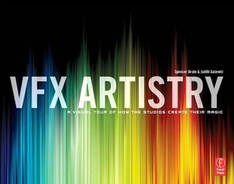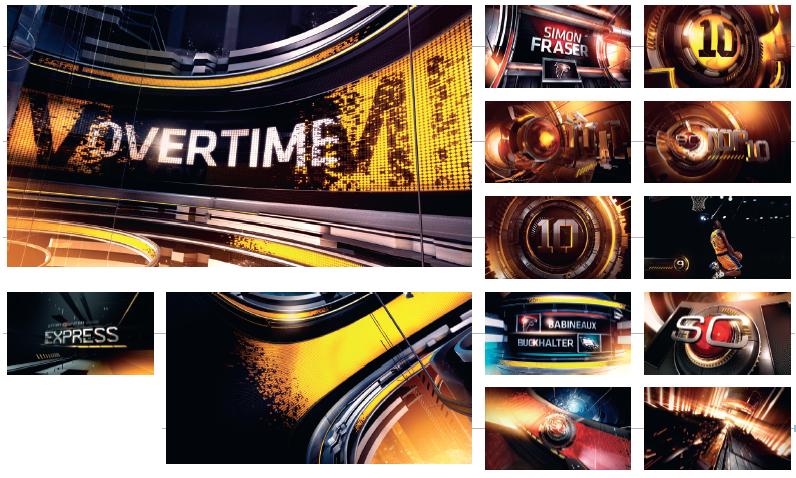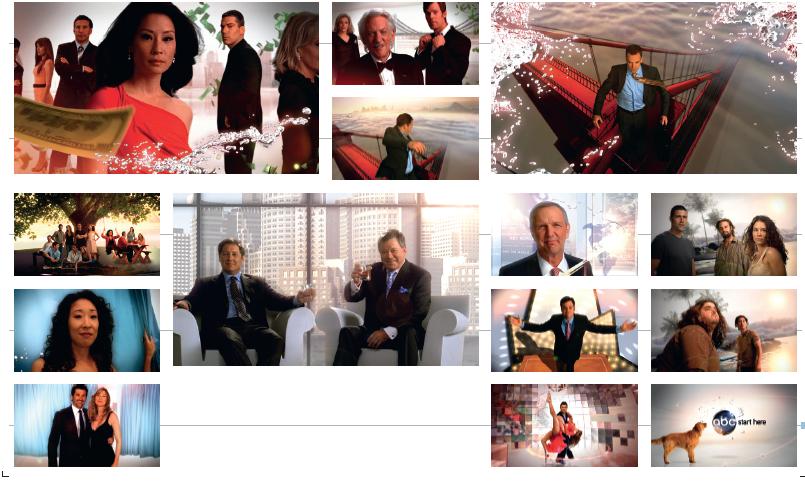10 TROIKA DESIGN GROUP, INC
STUDIO PHILOSOPHY
Troika Design Group is an award-winning design agency based in Hollywood, CA. Catering to clients in media and entertainment since 2001, Troika engineers large-scale brand campaigns notable for their innovative design, writing, and high-end production values. A team of more than 25 designers, producers, 3D and 2D animators, and effects artists, editors, and conceptual thinkers work from Troika’s state-of-the-art studios for clients including ABC, ESPN, TNT, Starz, FOX, the CW, NBC Sports, Oxygen, truTV, Animal Planet, HGTV, and the Golf Channel. Capabilities include end-to-end live action and digital production, from conceptualization through to final delivery.
GOLIATH: SPORTSCENTER REBRAND
Creative and Production Process In 2004 Troika created an identity package for ESPN’s flagship SportsCenter show as it went into high definition. Four years later we were asked to refresh the package concurrent with the launch of a West Coast SportsCenter studio and show in Los Angeles. This was a unique opportunity to take an existing design to new heights that couldn’t have been imagined earlier.
Evolving from our original “Revolution” 3D sports turbine concept, we introduced GOLIATH, a hi-tech, futuristic sports-machine world with beyond-imagination-scale and deeply detailed turbine elements. Our concept was a prequel to “Revolution,” taking viewers on a warp-speed journey from the birth of the fiery, liquid-hot, red “sports sphere” that lives at the heart of the SportsCenter logo to the moment of impact at the logo’s resolve. This immersive journey catapults sports fans from the massive download center “Base Camp” through a three-tiered world of activating turbine rings and video screens showcasing clips, straight into the set with an intense energy that is uniquely SportsCenter.
While our goal was to bring colossal scale to the SportsCenter identity, GOLIATH also had to be user-friendly. In addition to creating many final animations for ESPN, we also needed to provide them with working elements, which we call a toolkit, that will be utilized by their internal team to meet the ongoing needs and the extreme production demands of a daily nine-hour block of high-profile, live television programming.
Thus, our true innovation was building the expansive, multi-dimensional world of GOLIATH to perform as a 3D virtual set, allowing the ESPN team to use the model as delivered with all lighting, textures, and materials in place, or simply rearrange, scale, or combine any elements to create new staging areas with unlimited possibilities. It became a living toolkit and creative philosophy: composed of design and animation elements, delivered as project files, and built with the ultimate level of artistic flexibility and production efficiency.
GOLIATH wasn’t “built in a day”; in fact, it took multiple sketch 2D and 3D teams months to realize its massive, overscaled world. Concept artists created initial development boards and rendered pencil-sketched frames to inspire 2D vector line work for the toolkit of turbine rings, logo elements, and environment components.
Our creative teams designed and modeled hundreds of individual components, each engineered with unique functions and performance. Every element had to be independently successful while also able to combine or lock together, like puzzle pieces, to create the full GOLIATH environment. Several artists worked across dual Maya and C4D platforms during this phase, which was technically challenging but had successful results.
Mood boards and style frames were then created in Photoshop along with motion development in Maya and C4D to model elements for pre-visualizations. Rough Maya and/or C4D animatics established motion blocking for storyline development or elements, while Final Cut Pro handled editing. Once animatics were approved, we refined the environment architecture, texturing, and initial lighting pass. Each element went into final lighting passes out of 3D and into After Effects for compositing and finishing.
And because we were using multiple 3D platforms with Maya as the primary, we had to create a workflow that would maintain continuity among software. Models were exchanged by exporting FBX formats, and lighting, rigs, materials, and texture maps were reapplied and tweaked to achieve an eye match for most of the dual setups.
With creative and production teams totaling 20 people, we had 12 weeks from approved design to delivery, which included all final 3D project files prepared for seamless handoff to ESPN on all requested platforms: Autodesk Maya, Maxon C4D, VIZRT, and the standard Adobe Suite of After Effects, Photoshop, and Illustrator software.
Tools Maya 2008 U nlimited Service Pack 1 (64-bit version for Windows XP rendering), Cinema 4D version 10.5, After Effects CS3 version 8.0.2.27
Credits
Executive Creative Director/Partner Dan Pappalardo
President/Partner: Chuck Carey
Creative Director: Gilbert Haslam
Executive Producer: K risten Olsen
Producer: Claudina Mercado
Animators: Cory Strassburger, Mark McConnell, Jim McDaniels, Marco Bacich
Designer/Animators: Craig Stouffer, Ming Hsiung, Maziar Majd, Everett Campbell, Nick DiNapoli
Producer: Beth Elder
Design Assistant: Mindy Park
ABC
Creative and Production Process To promote the fall launch of ABC’s 2008/09 season, we created a series of 30- and 60-second spots in a brand campaign that features the network’s many memorable stars and personalities and represents a contemporary version of the big, feelgood, celebratory TV network promotions of a generation ago. The campaign brought together over 80 of ABC’s top talent using a combination of live action, CG environments, and digital compositing.
The spots create a seamless visual journey through the many stories, characters, and personalities on ABC. A consistent camera move was used throughout every scene as a unifying device. The camera pulls back in space to reveal one iconic show environment after another while introducing an endless stream of ABC stars.
The notable lineup of stars included Donald Sutherland, William Shatner, James Spader, Eva Longoria-Parker, Felicity Huffman, Marcia Cross, Matthew Fox, K ate Walsh, Sally Field, Jimmy Kimmel, Patrick Dempsey, Sandra Oh, and Christina Applegate. We created nine spots in all, each featuring a different group of shows. For example, one spot focuses on primetime hits while another combined the full scope of programming on ABC, including primetime, daytime, late night, and ABC News.
The sheer number of talent was daunting. The project required eight days of shooting to accommodate the primary cast members from all of ABC’s top shows, each of whom was on a different production schedule and filming in a variety of locations around the country. To accommodate their schedules, ensemble cast members were often filmed at different times, requiring additional compositing in postproduction to make it appear as if the entire cast were together.
We shot 35 mm film on greenscreen over the course of six weeks on stages in Los Angeles and New York. The seamless camera move was created using a 50-foot Technocrane, which enabled us to travel the camera very quickly and accurately over a significant distance. It was necessary to capture each scene in a brief two– to four-second shot with the camera operator and the talent hitting their marks at the exact right moment. This was tricky, and we were working within a limited block of time with each of the stars.
Motion control was an option, but the pace of the shoot, with a schedule of up to six show casts in a day, made the extended setup time impractical. Instead, we opted for speed on set, in which time with the stars is precious. This left us with a considerable task in postproduction, as practically every star had to be tracked and animated by hand to construct the scenes.
To further complicate things, the spots could not be built as complete linear pieces. Editorial flexibility was critical, so each ABC show had to be built as an individual modular scene. Camera movement, action within the scene, and secondary CG elements were all used to create invisible transitions that allowed the shows to be arranged in any order while still flowing seamlessly from one to the next.
Pre-pro was essential to the process. We began with hand-drawn animatics and 3D motion tests to work out the structure of the spots, including the camera move linking all the modular scenes together. We then composited rough versions of each scene for blocking purposes prior to shooting, using a combination of existing footage and pencil drawings. The composite scenes were updated with actual footage as it became available, which provided us with the most accurate reference for shooting any remaining talent.
The main scene compositing was achieved in Autodesk Flame over a nine-week, 24/7 schedule. All editorial and final compositing was done in Apple Final Cut Pro and Adobe After Effects. The entire process from conception to completion spanned seven months and involved a design and production team of over 50 people.
Tools Maya 2008, After Effects CS3 version 8.0.2.27, Final Cut Pro version 6 [w/Twixtor], Autodesk — Flame [with Sapphire plug-ins], PF Tracker, Adobe PhotoShop CS3.
Credits
Executive Creative Director: Dan Pappalardo
Executive Producer: K risten Olsen
Producers: Chris Gernon, K elley McDermott, Jess Ferguson
Designer/Art Director: Earl Jenshus
Coordinator: Christopher Belanger
Editor: Chris Gernon
Flame/Compositors: Jeff Heusser, Maribeth Emigh, Andy Edwards, Matt Trivan
3D Animators/CG Artists: Jason Mortimer, Cory Strassburger, Candida Nunez, Adrian Dimond, Jeff Sargeant
Animators: Jun K im, Jim McDaniels
Tracker: Michael Moorehouse
Assistant Editor: Marisol Mcllvain
2nd Assistant Editor: Jeff Hayford
Storyboard Artists: Chad Glass, K az Mayeda, Elizabeth Colomba




